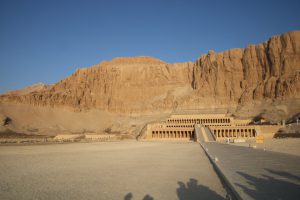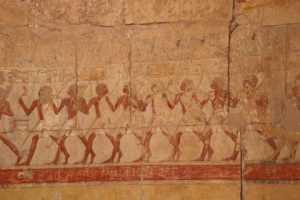We were eating breakfast just after 5:00 a.m. in order to beat the heat (40C) and any crowds on the West Bank. Tour buses from the Red Sea resorts generally arrive by 11:00 a.m. and ones from Luxor even earlier. Our mission was to avoid the crush. We did!! We have never seen empty coach parks on the West Bank.
The first port of call at 06:30 was the Memorial Temple of Hatshepsut (Deir Al Bahri). The site is dominated by very dramatic towering limestone cliffs that rise some 300 m above the desert. The monument is extraordinary for it has a modern, almost 1960s look about it. It is the limestone, which is strongest in blocks of the same size that results in the design of the building. For the most part it is a reconstruction.
Hatshepsut was a female pharaoh and this temple was to be a clear record of her initiatives in a male world. The detailed reliefs of the expedition to the Land of Punt (Eritrea and possibly the Horn of Africa) was to collect myrrh trees needed for the incense used regularly in her country. She also obtained strange (to the Egyptians) donkeys and sea fish, for example, along with exotic food plants, architectural ideas and a record of the facial features of ‘foreign people’.
Unfortunately vandalism by rival pharaohs has led to her name being removed and additional damage caused by early Christians to what they called Pagan reliefs.
Still on the West Bank we moved to the Valley of the Kings. This area directly across the river from Luxor has been the royal burial site since 2100 BC, but the Pharaohs of the New Kingdom around 1550 BC chose this isolated limestone gorge surrounded by mountains for the 63 magnificent royal tombs. The entrance ticket allows a visit to three tombs which are rotated in order to preserve them. Large numbers of visitors increase the humidity and can destroy the paintings. Today we visited one tomb we had not seen before. The disappointing element was the fact that our cameras could not be used even outside in the valley. A guide said that a certain nationality broke all the rules regarding photography so except for mobile phones all photography has stopped. Our photographs taken nearby give an impression of the area.
On the edge of the West Bank site are two statues representing Pharaoh Amenhotep III standing 18 m above the flood plain. They were damaged in an earthquake in 27 BC and, until recently, stood isolated as a photo stop en route to or from the West Bank. Excavations are currently taking place and more of the site is being revealed. They are known as the Colossi of Memnon and were a tourist attraction during Roman times. Both the Greeks and Romans considered it good luck to hear a whistling sound emitted by one of the statues at sunrise. They believed it to be the cry of Memnon but was probably sand resonating inside the cracks of the statue.
Later this afternoon we visited the massive complex at Karnak dominated by the Temple of Amun-Ra with a spectacular hypostyle hall which is like being in a stone forest of giant papyrus and lotus flower-shaped columns.
Recent finds here include the Quay of Amun where large boats carrying the statues and obelisks unloaded. On our last visit here in 2010 the quay had just started to be investigated.
The site is more than just a temple as it is a complex collection of sanctuaries, pylons, and a sacred lake which to us looks very similar to a tank used as water storage in settlements of the Indus Valley Civilisation at the same time. Amazing!!

























